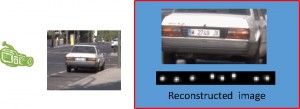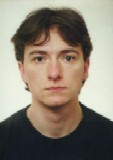 Filip Šroubek received the M.Sc. degree in computer science from the Czech Technical University, Prague, Czech Republic in 1998 and the Ph.D. degree in computer science from Charles University, Prague, Czech Republic in 2003. From 2004 to 2006, he was on a postdoctoral position in the Instituto de Optica, CSIC, Madrid, Spain. In 2010/2011 he received a Fulbright Visiting Scholarship at the University of California, Santa Cruz. Currently he is with the Institute of Information Theory and Automation, Academy of Sciences of the Czech Republic. His talk takes place on Tuesday, February 24 at 11am in room E105.
Filip Šroubek received the M.Sc. degree in computer science from the Czech Technical University, Prague, Czech Republic in 1998 and the Ph.D. degree in computer science from Charles University, Prague, Czech Republic in 2003. From 2004 to 2006, he was on a postdoctoral position in the Instituto de Optica, CSIC, Madrid, Spain. In 2010/2011 he received a Fulbright Visiting Scholarship at the University of California, Santa Cruz. Currently he is with the Institute of Information Theory and Automation, Academy of Sciences of the Czech Republic. His talk takes place on Tuesday, February 24 at 11am in room E105.
Advances in Image Restoration: from Theory to Practice
 Abstract: We rely on images with ever growing emphasis. Our perception of the world is however limited by imperfect measuring conditions and devices used to acquire images. By image restoration, we understand mathematical procedures removing degradation from images. Two prominent topics of image restoration that has evolved considerably in the last 10 years are blind deconvolution and superresolution. Deconvolution by itself is an ill-posed inverse problem and one of the fundamental topics of image processing. The blind case, when the blur kernel is also unknown, is even more challenging and requires special optimization approaches to converge to the correct solution. Superresolution extends blind deconvolution by recovering lost spatial resolution of images. In this talk we will cover the recent advances in both topics that pave the way from theory to practice. Various real acquisition scenarios will be discussed together with proposed solutions for both blind deconvolution and superresolution and efficient numerical optimization methods, which allow fast implementation. Examples with real data will illustrate performance of the proposed solutions.
Abstract: We rely on images with ever growing emphasis. Our perception of the world is however limited by imperfect measuring conditions and devices used to acquire images. By image restoration, we understand mathematical procedures removing degradation from images. Two prominent topics of image restoration that has evolved considerably in the last 10 years are blind deconvolution and superresolution. Deconvolution by itself is an ill-posed inverse problem and one of the fundamental topics of image processing. The blind case, when the blur kernel is also unknown, is even more challenging and requires special optimization approaches to converge to the correct solution. Superresolution extends blind deconvolution by recovering lost spatial resolution of images. In this talk we will cover the recent advances in both topics that pave the way from theory to practice. Various real acquisition scenarios will be discussed together with proposed solutions for both blind deconvolution and superresolution and efficient numerical optimization methods, which allow fast implementation. Examples with real data will illustrate performance of the proposed solutions.
